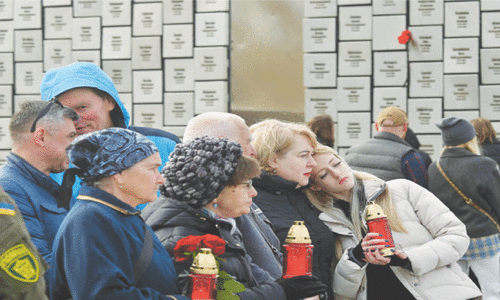Last week's column on the subject of Karachi's transport, traffic and flyovers generated many responses, most positive, some negative.
There were those who felt that other urban problems (polluted water, adulterated food, power shortage, etc) took precedence, others proposed a charge on cars entering the inner city, some decried the burgeoning of cars on scarce CNG, others advocated high parking charges to discourage private vehicles, and many blamed the curse of corruption which ate up money meant for urban development; one remark was that buses also used the flyovers, thereby missing the point of the column.
One germane comment “Flyovers, in addition to being a huge financial burden, waste vital public space, encourage urban sprawl and shift bottlenecks from one place to another. They are built for citizens driving Hondas, Corollas and BMWs. These structures do amazingly well to move vehicles faster only for a few years at best before the flyover becomes clogged with new cars that others are thereby encouraged to introduce on the roads.”
This fact was not recognised by the Sindh Environmental Protection Agency (Sepa) which, in much haste, accorded Initial Environmental Examination (IEE) sanction to the Rs1.3bn Signal-free Corridor-IV (Sharea Faisal) city government (CDGK) venture, in violation of the requirements of the Pakistan Environmental Protection Act 1997.
Sepa has a history of lamely 'approving' projects after they have commenced in violation of the law, e.g. the Gizri Flyover, Tuwairqi Steel, and many others. Additionally, projects that fall under the more onerous requirements of an Environmental Impact Assessment (EIA), including a public hearing, are relegated to the simpler IEE category, and condoned in-house by Sepa. This was the case with the DHA Cogen/Desalination plant until the Sindh High Court directed that the EIA be conducted. We need to inject backbones into our regulatory agencies.
Non-implementation of affordable and convenient public transport systems in Pakistan's cities has played havoc with vehicle congestion, air and noise pollution, fuel wastage and futile man-hours in traffic jams. For instance, government studies show that over the past 10 years, air pollutants in Karachi have increased between 50 and 560 per cent, thus exacerbating respiratory diseases and human suffering.
Over recent decades, the city of Karachi (KMC and then CDGK) has undertaken numerous traffic and related studies through the Karachi Mass Transit Cell (KMTC), and has evolved varied technical solutions and schemes to tackle transport issues. But it is increasingly difficult to convince the small thinkers among the powers-that-be to divert funds from politically expedient road-widening, overpasses/underpasses and flyovers to projects that would serve the city and its inhabitants now and in the future.
Last year I wrote on the Bus Rapid Transit System (BRTS) fiasco that became the victim of the 'cold war' between the PPP and the MQM. Based on a 2005 design of the KMTC, segregated bus-ways were to be established initially along three priority corridors in the city which would cater to 470,000 passengers per day using 33 stations at about 1.4km intervals Surjani Town to Mazar-i-Quaid and railway stations along the North Nazimabad/Nazimabad/Jinnah Roads (25km), Safoora Goth to Mazar-i-Quaid along University/Jinnah Roads (16km), Orangi Town to Board Office (4km).
The proposed Asian Development Bank (ADB) sponsorship, along with the $450m loan, was withdrawn by the ADB in December 2008 as the Government of Sindh (GoS) and the CDGK could not agree on who would run the programme. We now learn that after a brooding period of almost a year the GoS wishes to resurrect the BRTS system for Karachi and woo back the ADB.
Complementing the proposed Karachi BRTS was the public/private partnership-based environment-friendly CNG Bus System for which the Planning Commission in Islamabad allocated a Rs5bn subsidy in 2005. Sponsorship of the project was given to the Ministry of Environment (MoE) in 2008, and in April 2009 new impetus was generated by re-christening it the Shaheed Benazir Bhutto CNG Bus Project.
Four thousand buses (1,400 by 2010; an additional 1,600 by 2012; and a further 1,000 by 2014) are projected to serve 4.6 million passengers every day. These buses will cover the rest of the city and serve as feeders for the BRTS system.
After a five-year delay, this month a request-for-proposals was floated by CDGK for 70 and 100-passenger CNG buses to operate on 40 'Green Routes'. Additional facilities like exemption from import taxes, 2080 equity-debt ratio, a Rs300,000 upfront grant and Rs371,181 interest subsidy per bus, gas quota for fuel stations and provision of terminals are also on the cards (nine bus depots that were saved in 1977 by the Sindh High Court from being commercialised and sold are available).
The MoE and the State Bank are in the process of ironing out the financing protocols for commercial bank loans.
Karachi needs the BRTS and the CNG Bus Project urgently. Too many valuable resources (time, money, physical and mental health) are being wasted every day on the massively congested streets of the city. Those that lose most from the lack of vision of our ministers, parliamentarians, nazims and municipal administrators are the citizens, the taxpayers (remember that a substantial part of our taxes are indirect and are paid by the poor).
Were our so-called leaders forced to travel in rickety buses and coaches, rather than in motorcar convoys with traffic stopped as they whiz along using police mobiles to make their way through city congestion, the issue of better public transport might be foremost on their agenda. They might then take into account the related benefits of far fewer private cars, reduced road chaos, cleaner air, lower noise levels, smaller fuel-import bills and shorter trip times.











































